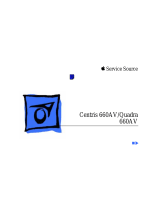Page is loading ...

Basics PowerBook Screw Matrix - 4
Legend for Macintosh PowerBook 550c Screws
1 Feet
2 Hard drive, keyboard, bottom case (middle front),
display assembly, floppy drive, daughterboard EMI
shield (top edge), inside edge of top case, right side panel
3 Display bezel, display, clutch, DAA
4 Trackpad cable and actuator, daughterboard EMI shield
(sides), motherboard standoff
5 Rear panel
6 Hard drive bracket
7 Inverter board, interconnect board
8 Bottom case (front corners), left side panel
9 Floppy drive bracket

Basics PCMCIA Module Handling - 6
PCMCIA Module Handling
The PCMCIA (Personal Computer Memory Card
International Association) expansion module is an option for
the Macintosh PowerBook 550c. The module inserts into the
computer’s second (left) battery bay and has two slots that
accept a variety of third-party PCMCIA cards.
There are three types of PCMCIA cards: Type I (3 mm),
Type II (5 mm), and Type III (10 mm). Type I and Type II
cards fit in either the upper or lower slot of the expansion
module. Type III cards fit in the lower slot and take up both
slots.
The following are guidelines for properly handling the
PCMCIA expansion module:
• Do not insert or remove the PCMCIA expansion module
while the computer is on or in Sleep mode. if you do, the

Basics PCMCIA Module Handling - 7
computer will shut down and all RAM contents will be
lost.
• Eject the PCMCIA module using the lever at the front of
the module; eject a PCMCIA card using the PCMCIA Eject
control panel or the PCMCIA Quick Eject module in the
computer’s Control Strip.
• Keep the protective cap that comes with the module and
place it back on the module when it is not in use.
• Do not open the module or insert anything other than a
PCMCIA card into the card slots.
• Keep the module in a safe place, away from small objects
that might fall into it.
• Before ejecting a PCMCIA card, make sure nothing is
blocking the card’s slot. To immediately reinsert the
card, pull it out an inch more and then push it back in.
• Use only cards that are compatible with the PCMCIA
expansion module. Refer to the compatibility
information that came with the card.

Basics Battery Information - 8
Battery Information
The Macintosh PowerBook 550c includes two nickel-
metal-hydride (NiMH) batteries. Each battery provides
power for up to 3.5 hours of work time, depending on the
battery conservation features employed. A smart processor
included in each battery pack indicates the battery’s charge
status.
For instructions on how to verify the battery voltage, see
the Additional Procedures chapter of this manual.
For additional information on PowerBook batteries,
voltages, ampere hours, and part numbers, see the
PowerBook Battery Matrix in Hardware/Compatibility
Charts.

Basics Battery Information - 9
Battery Handling
±
Warning:
NiMH batteries contain toxic materials. Send
undamaged, dead batteries to Apple for recycling—do not
discard dead batteries with other waste. If the battery is
damaged, do not return it to Apple. Dispose of damaged
batteries according to local ordinances. Review battery-
handling and disposal instructions in Bulletins/Safety.
The following are guidelines for properly handling the
Macintosh PowerBook 550c battery:
• Handle the battery carefully. Do not drop, puncture,
disassemble, mutilate, or incinerate it.
• Do not short-circuit the battery terminals.
• Do not leave a battery in the computer for longer than a
week without plugging in the power adapter.
• Do not leave the battery in hot locations (such as the
trunk of a car).

Basics Battery Information - 10
• Keep the battery in a cool, dark place; do not store it for
longer than 6 months without recharging.
• If you are using one battery: Completely discharge and
then recharge the battery once every 90 days.
• If you are using two batteries: Swap the left and right
batteries every month.
• Fully charge a replacement battery before using it;
Apple ships batteries in a partially charged state.

Specifications Memory - 2
Memory
RAM
4 MB RAM installed on the daughterboard
Expandable to 12 MB with 8 MB Apple RAM expansion card
Expandable to 36 MB with third-party RAM expansion card
ROM
2 MB
PRAM
256 bytes of parameter memory
VRAM
512K of static video display memory
Clock/Calendar
CMOS custom chip with long-life lithium battery

Specifications I/O Interfaces - 4
I/O Interfaces
SCSI
HDI-30 SCSI port with 1.5 MB/sec. transfer rate
Supports up to six external SCSI devices
Connect SCSI device to computer with HDI-30 SCSI system cable.
Apple Desktop Bus
Apple Desktop Bus (ADB) port
200 mA maximum current draw for all ADB devices
Serial
RS-422 serial port; mini DIN-8 connector
Sound
Stereo sound-in port
Stereo sound-out headphone jack; standard 3.5 mm stereo
miniplugs

Specifications I/O Interfaces - 5
Video
Micro DV-14 video-out port; 8 bit, 256 color video output
Supports most Macintosh, VGA, and SVGA monitors
Ethernet
High-speed Ethernet port; Apple AUI connector
Processor-Direct Slot
90-pin processor-direct slot (PDS) for PDS devices or optional
Personal Computer Memory Card International Association
(PCMCIA) adapter/PCMCIA expansion module (allows use of
two Type II or one Type III PCMCIA-type card)
Power Adapter
Power adapter port
Modem
Slot for optional internal modem
Security
Slot for third-party security equipment

Specifications Sound and Video - 7
Sound and Video
Sound Generator
Apple sound chip provides 16-bit sound capable of driving stereo
headphones or other stereo equipment through the sound jack
Built-in stereo speakers
Video Display
10.4-in. diagonal screen
Backlit, active-matrix color display; 640 x 400 pixels at
thousands of colors; 640 x 480 pixels at 256 colors
/















